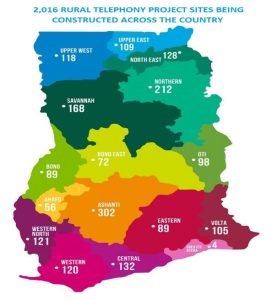Our government is using digital technology to stimulate growth in the economy” – President Nana Addo Dankwa Akufo-Addo, at the launch of MTN Ghana’s 25th Anniversary in June 2021
Ensuring universal access to internet connectivity remains a topmost priority on the development agenda of the Government of Ghana. The government has over the years committed to making digitalization a key driver of sustained and inclusive economic growth. Consequently, Ghana, today, is on the cusp of a digital economy, and now more than ever, closing the digital divide has become a very important goal especially as it relates to achieving the UN Secretary-General’s Digital Inclusion Goals and more importantly, to support the country’s post COVID-19 pandemic recovery process.
Access to connectivity is creating opportunities in various ways for the citizenry, especially for households considered poor. For example, the introduction of digital payment systems such as mobile money platforms are enabling financial inclusion for many people who hitherto had no opportunity of having a bank account. Similarly, through the power of connectivity, the barriers to education are gradually being dismantled and the frontiers of education are expanding with the adoption of eLearning, distance training, distance learning and massive open online courses (MOOCs) as normative forms of education in a modernized economy. There is further empirical evidence of immense benefits associated with connectivity being recorded across other sectors of the economy such as health, agriculture, governance, among others.
Current data on digitalisation position Ghana as one of the leading countries in Africa. The quarterly report from the regulator, the National Communications Authority (NCA), puts total penetration for voice at 130.37% as at the end of June 2022, with actual subscriptions pegged at 40.98 million. Regarding internet penetration, there has been an exponential increase in penetration from 2.31 million in 2012 to about 17 million users in 2022, which is about 53% of the population (Antwi-Boasiako, A, 2022, National Cybersecurity Awareness Month). Though these statistics are spectacular, the reality is that about 40% of the population remains unconnected to the internet. A more recent data compiled by the Ghana Statistical Service prior to the commencement of the 2021 Population and Housing Census (PHC) identified a coverage gap in almost 12,000 communities across the country, with about 30% of the population reported to be living in rural areas. These areas are noted to have some peculiar characteristics such as low population density, low-income levels, challenges with topography particularly around the middle belt of the country, and distance between settlements. These peculiarities have been the major barriers for the Mobile Network Operators to establish their footprints in these communities. Simply put, the economics are just unattractive.
To remedy the situation, the Government of Ghana launched the ambitious Ghana Rural Telephony Project and Digital Inclusion Project (GRTP & DIP). Financed with a €155 million loan secured from the China Exim Bank under the auspices of the Ministry of Communications and Digitalization, the project is designed to extend connectivity to 2,016 unserved communities identified across the country using the Ghana Investment Fund for Electronic Communications as implementing agency. It is executed on a Public Private Partnership basis with a novel Tripartite Revenue-Share Model among the key partners.
The success of the project was however hinged on the type of technology required to address the peculiar rural characteristics mentioned earlier - a technology that will provide seamless and reliable voice and data connectivity to all residents, no matter where they reside, while ensuring that the selected Mobile Network Operator (MNO) could achieve a Return on Investments (RoI), or in the worst-case scenario, break-even. Through extensive research, the consortium (GIFEC, HUAWEI and MTN) developed the innovative Rural Star Technology as a site infrastructure for the project. Designed as a lightweight rural network coverage solution, it supports 2G, 3G and 4G connectivity and entails some 50 per cent savings on the cost of traditional cell sites. This allows the project to be economical and financially viable thereby generating good returns on investment.
A key advantage of using the Rural Star technology was that, potentially, more communities could be selected as beneficiaries as they satisfy the criteria compared to the requirements under the previous Rural Telephony Project. For example, the population criterion was lowered from 2000 to 500 programme (not sure if the word programme should be here) provided there were social amenities like a school, market, etc that could stimulate and sustain demand for internet services within the enclave.
This project gives hope for the over 3 million people residing in these communities to adopt and adapt to the use of ICT in their daily activities. These people will have equal opportunity to access innovations being introduced by the government in its digital transformation drive. Some of these include using digital means to acquire basic needs such as a passport, driver’s license, registration of business (e-business), purchase of drugs (e-pharmacy), purchase of tickets for social events (e-ticketing), clearing of goods from the port using the paperless port clearance system, securing a unique geo-located digital address system, national identification card, and many others.
ICT has become so critical to everyday life that the government could not afford to deny any of its citizenry access to network. Government aimed to establish more than 1,000 cell sites across the country by the end of 2020” - Ursula Owusu-Ekuful, Minister of Communications and Digitalisation
On November 4, 2020, the first site was successfully launched by the President of the Republic of Ghana, His Excellency Nana Addo Dankwa Akufo-Addo at Atwereboana, a rural community located in the New Edubiase District of the Ashanti Region. Subsequently, further deployments have been made in a span of two years. About 1000 more rural sites across the country have been connected, and more than 1.5million people, mainly poor and low-income households, have begun using digital services. Today, these previously unconnected citizens have been afforded the opportunity to participate fully in the now emerging digital economy especially in a post-COVID-19 pandemic era. Citizens have been given a voice in the governance and political process, are able to explore the economic benefits particularly for those operating in the Micro, Small and Medium Scale (MSME) enterprise sectors, interact more socially and are assured of enhanced education opportunities.

To ensure that no segment of the population is left unconnected, the project acknowledges the potential barriers existing within the beneficial communities. The issue of gender inequality is a priority. Many of the women do not possess the relevant skills to access digital resources. A gender gap is estimated to be close to 10%. This is however more pronounced in rural areas with more than half of the population not using any form of ICT in general. As part of the project implementation, beneficiary communities receive digital literacy programmes that the Ministry is implementing through GIFEC. For example, this year the annual Girls-In-ICT programme is earmarked to train 5,000 girls in five regions. So far, 3000 girls have received training with the remaining 2000 expected to be completed before the end of 2022. Similarly, the Digital Transformation Centre (DTC) project will train 14,000 people drawn from diverse backgrounds in basic and intermediate ICT skills. A significant portion of the beneficiaries is earmarked for women. Other interventions such as the ICT for Women Empowerment (ISEWE) and Girls can Code are deliberate actions designed to improve digital literacy skills of connected communities under GRT & DIP and both cumulatively have trained over 2000 women in the past two years.
To function effectively in the digital economy, it is essential to build the capacity of Ghanaians, to take full advantage of the 4th Industrial Revolution, which has fundamentally changed the way we live, work and relate with each other, through technology”-Prince Sefah, Administrator, GIFEC
The issue of cybersecurity and its related privacy interests of users, particularly women, also remain central to the issue of Digital Inclusion in rural areas. One cannot lose sight of the fact that these communities are typically steeped in culture and some of their beliefs and practices do not encourage women to be receptive to the use of such modern tools. The Ministry has since 2018 established a National Cybersecurity Authority (NSA) which dedicates the month of October as an awareness month for cybersecurity. The activities of the NSA are undertaken nationwide, and therefore not surprising since the commencement of the programme, more women are changing their opinions and gaining the needed confidence in the use of digital tools.

Similarly, providing assistive technologies to persons with disabilities to enable them to become a part of the digital economy is one that has gained the utmost attention under the project. GIFEC is supporting several institutions by way of assistive technologies and training to enable their effective participation in the new economy. In collaboration with the German Development Agency (GIZ), GIFEC has commenced a training programme in some of the GRT & DIP communities where it is organizing extensive training to people including persons with disabilities.
The importance of connecting the unconnected cannot be underestimated. There is no doubt that this period presents the most opportune time for Ghana to leapfrog its development to achieve her goal of a Ghana Beyond Aid. The current global economic turmoil facing economies such as Ghana notwithstanding, the future and hope for any economic recovery hinges on digitalization.
Source: Victor Asante, Head of Research and Innovations, GIFEC

Comments